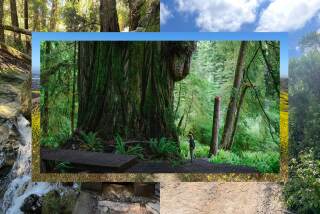A Beacon Dims and Neighbors Are Fuming
PIEDRAS BLANCAS, Calif. — Along this ruggedly beautiful stretch of the Central Coast, where elephant seals sun on the beaches and Hearst Castle looms in the distance, residents have been fuming ever since the U.S. Coast Guard dimmed the light.
The giant beacon atop the landmark Piedras Blancas lighthouse, which for decades has cast a glow for 25 miles in all directions, burned out last year. So the government replaced it with a puny light.
“I’m not going to argue with the fact that it might not be necessary for navigation,” said Michael Donahue, a dental hygienist from nearby Cambria who lost his nighttime view of the lighthouse. “But it’s part of the character and charm of what this place has been for over 100 years.
“How do you put a price on the romantic coast? They might as well put a flashlight up there for how it looks now.”
The controversy has reminded the Coast Guard once again that when it is managing lighthouses, landlubbers often get in the way. And the dispute raises the question of what role lighthouses really play in a high-tech age when even amateur mariners tend to look down at their global-positioning systems instead of out into the darkness for a pulsating beacon.
“We’ve downgraded a number of spots to what we call minor aids to navigation,” said Cheryl Rosati, an Oakland-based signal management assistant for the Coast Guard. “For the most part, mariners have a lot more technology these days. The major aids like lighthouses are tremendously expensive to maintain, and we have to focus on our primary mission, which is helping those at sea.”
The new light at Piedras Blancas now reaches just 10 miles, three miles short of Cambria. Since residents complained last fall, the Coast Guard has decided to seek money to rewire the lighthouse tower for a brighter bulb whose light will reach the town. Rosati said funding is not expected before October.
The lighthouse stands just off of California 1 at the northern end of San Luis Obispo County. It heralds the start of the scenic Big Sur coast.
When first illuminated in 1875, Piedras Blancas was the only lighthouse along the hazardous stretch of coast from Santa Barbara to Monterey. Lights later were added at Port San Luis and Big Sur.
The 74-foot Piedras Blancas tower anchors an 18-acre patch of federal land so rich in wildlife that researchers are housed on the site to count gray whales, sea otters, endangered frogs and the tiniest of intertidal creatures.
“There are more biologists doing research here, acre for acre, than just about any [other] place in the country,” said Norm Scott, a herpetologist who works there for the U.S. Geological Survey.
Piedras Blancas is one of the best sites in the lower 48 states to count mother whales and their calves returning from Baja California to the Bering Strait, biologists say. The grays come within a stone’s throw of shore to confuse the sonar of killer whales that hunt the calves.
Even Piedras Blancas’ biologists lament the change atop the lighthouse.
“That light going out into the night was so beautiful,” said Wayne Perryman, who heads up the whale count for the National Marine Fisheries Service. “We live out here three months every year. Now the light is honestly an embarrassment.”
The lighthouse is run down and needs paint, but there are plans afoot to establish a wildlife refuge on the surrounding property.
Because of the sheer abundance of species there, the U.S. Fish & Wildlife Service is working to have Piedras Blancas designated a protected sanctuary, said Debora Guillot, a spokeswoman for the agency.
“That site is so precious from a resource standpoint,” she said. “You have the proximity to the whale migration, since it juts out into the ocean. You have the elephant seal haul-out, the otters in the kelp beds. Peregrine falcons even perch on the lighthouse.”
She said the lighthouse is on the National Historic Registry, and the federal government “has a huge obligation to protect cultural resources.”
Piedras Blancas has had a flat top since 1949, when the Coast Guard removed the original first-order Fresnel lens, one of the French-made beehive lenses that lighthouse keepers used to magnify gas-fired light for mariners far out to sea. The 4-ton lens now stands in a specially designed building in Cambria.
After the lens was removed, the Coast Guard turned to automated beacons, which remained in use until last year.
Kathe Tanner, a member of the Cambria Historical Society, hopes that the wildlife service will work with her group to restore the lighthouse structure.
“Maybe we could do tours every other weekend,” Tanner said. “We would never have something where people would be traipsing through the place ruining the research.”
Though the appearance of the lighthouse tower might improve, its light is not expected to ever shine quite as brightly again.
Jerry McKinnon, a Cambria resident who served in Korea with the Navy and was a Coast Guard reservist for decades, is pragmatic about that reality.
“We tend to think with our heads or our hearts. With your heart, you like to see it be pretty and grand,” he said. “With your head, you remember it’s a utilitarian piece of equipment. Times change.”
More to Read
Sign up for The Wild
We’ll help you find the best places to hike, bike and run, as well as the perfect silent spots for meditation and yoga.
You may occasionally receive promotional content from the Los Angeles Times.






